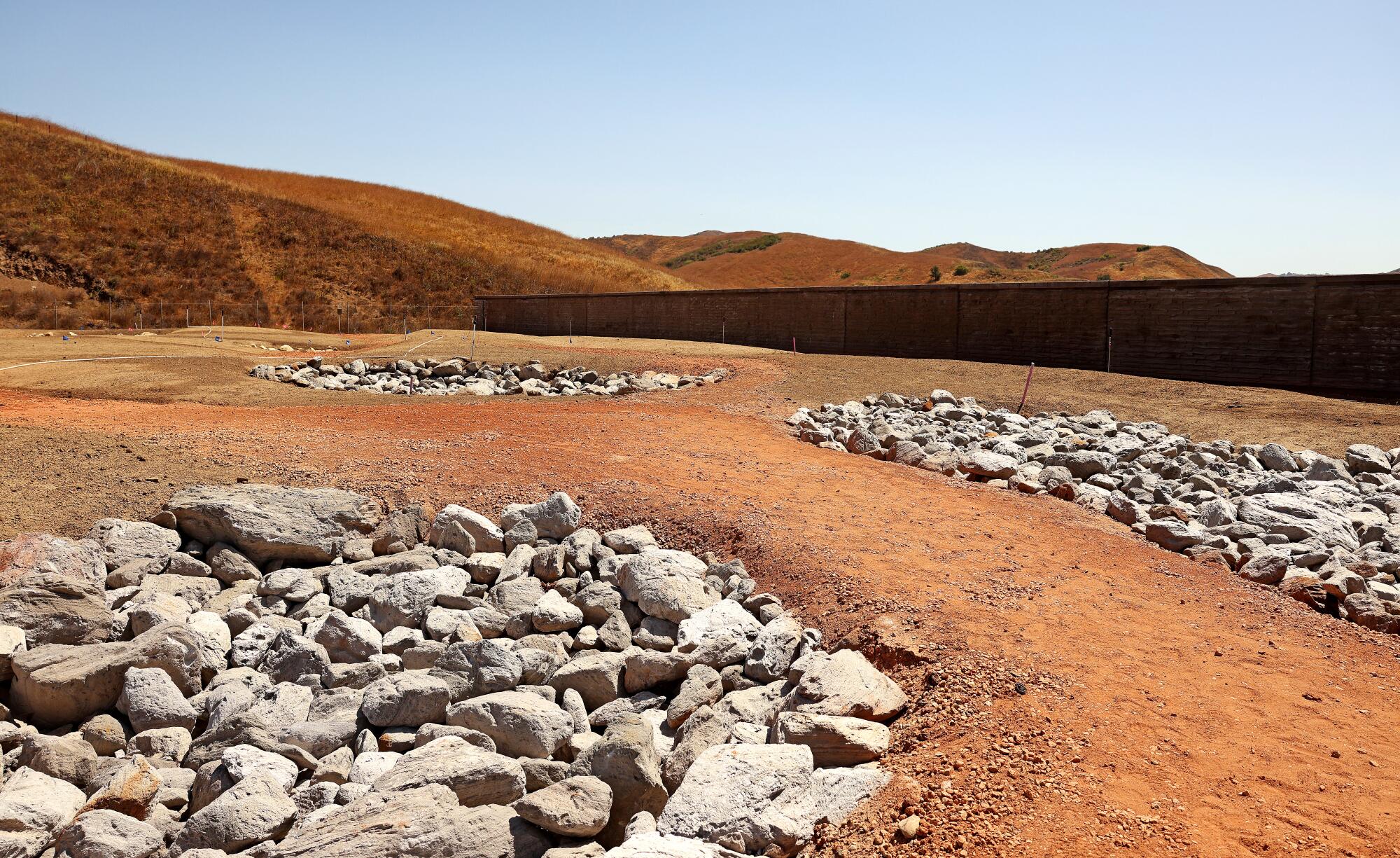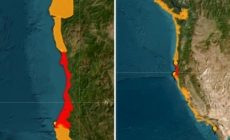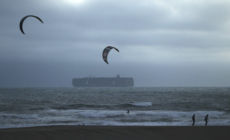-
Democrats, This Is Our Moment to Lead. We Can’t Blow It. - 35 mins ago
-
Trump Ally Marjorie Taylor Greene Becomes First Republican To Label Gaza a ‘Genocide’ - 40 mins ago
-
Hawaii Evacuation Videos Show People Fleeing Tsunami - about 1 hour ago
-
What Would Recognizing a Palestinian State Mean? - about 1 hour ago
-
Map Shows California, Oregon Tsunami Warning Red Zone - 2 hours ago
-
Senate, Rejecting Whistle-Blower Alarms, Confirms Bove to Appeals Court - 2 hours ago
-
Shooting at Granada Hills day care wounds 2; suspect arrested - 2 hours ago
-
Unexpected Passenger Boards Subway ‘Like She Was Headed To Work’—Goes Viral - 2 hours ago
-
Reno Shooting Shatters Lives at a Bachelor Party - 3 hours ago
-
Hiker in Yosemite sequoia grove killed by falling tree branch - 3 hours ago
Agoura Hills wildlife crossing project preps for partial road closures
When you’re trying to build a mountain over one of the country’s busiest freeways, it’s easy to be envious of original creation stories, when natural spaces were formed with just a wave of the hand.
In those stories, there were no overhead wires to bury or water lines to move. There weren’t vehicles to divert, underground creeks that required stabilization, majestic oaks that had to be saved or soils that required inoculation with local microbes.
But such are the looming challenges for the designers and builders of the Wallis Annenberg Wildlife Crossing, the world’s largest and most ambitious crossing designed to give wildlife a safe and nature-mimicking passage over the 10-lane 101 Freeway in Agoura Hills.
The crossing structure itself is mostly completed — except the planting, which will happen this fall — but it’s basically a bridge to nowhere right now, squatting over the freeway just west of the Liberty Canyon Drive offramp. (Although — news flash! — even though it’s not connected to the neighboring hills, the first non-insect wildlife was spotted on the bridge last week: a Western fence lizard basking at the top, roughly 75 feet above the traffic below.)
The second and final phase is installing the connectors — the structure’s shoulders that will permit freeway-fragmented wildlife to easily cross between the Santa Susana Mountains to the north and the Santa Monica Mountains to the south.
Expanding the areas where wildlife can safely roam will increase their chances of finding mates while improving the health and genetic diversity of everything from lizards to mountain lions like P-22, whose lonely life in Griffith Park helped inspire the crossing.
This second phase is the trickiest part of the project, especially the south-side connection over Agoura Road, according to Robert Rock, chief executive of Chicago-based Rock Design Associates and the landscape architect overseeing the $92.6-million project.

The Wallis Annenberg Wildlife Crossing connector to the south will be supported by a tunnel over Agoura Road, which will roughly be located between the two white trailers in the photo and then threaded (as much as possible) around the small grove of mature oak trees into the Santa Monica Mountains beyond.
(Jeanette Marantos)
Work on the south side requires burying overhead wires near the site, moving water lines for the Las Virgenes Municipal Water District, stabilizing an underground creek (dubbed No-Name Creek) that runs under the tunnel site to prevent erosion and then driving two walls of pilings deep into the ground for 175 feet along Agoura Road to build the 54-foot-wide tunnel that will span the road.
Once the tunnel is constructed and the concrete roof is poured, workers will literally be moving a small mountain of soil from the north side of the freeway, where it was piled when this stretch of the 101 was constructed in the 1950s, to cover the tunnel and create the sloping connecting shoulder into the Santa Monica Mountains.
The final work will be planting more native shrubs, perennials and trees on the shoulders and adding two miles of galvanized steel fencing on either side of the crossing to funnel animals over the crossing and away from human-made roadways and homes.
Easy peasy, right? Except for one more detail — they have to do all this building and earth moving without disturbing a sprawling grove of native oak trees growing around the site.

The designers plan to thread their way through the small grove of mature oaks on both sides of Agoura Road to preserve as many of the mature trees as possible when building the south shoulder of the crossing over the road and into the Santa Monica Mountains.
(Christina House / Los Angeles Times)
“It’s a tricky pocket,” said Rock. “We’re definitely threading a needle.”
Some of the smaller trees may have to be removed, he said, but the designers are doing everything they can to maintain the native trees growing around the site. Not surprising, because the whole project has focused on re-creating nature as much as possible on a foundation of concrete and steel, with native plants grown from seeds collected within a three-mile radius of the project and soil specially inoculated with local fungi and microbes to enhance their growth. The plants are being tended at the project nursery a few miles from the site.
C.A. Rasmussen Inc., the Valencia-based contractor who built the first phase of the project, has won the bid to do the second stage as well, said Rock. Weather delays — primarily from heavy rains in 2022 and 2023 — have pushed the crossing’s final completion date to the end of 2026. The state of California has provided $58.1 million of the $92.6-million project, as part of its “30 by 30” goal to conserve 30% of the state’s lands and coastal waters by 2030. The rest of the funds are coming from private donations.
Work on the final phase is expected to begin next week. Much of the prep work and tunnel construction will require at least a partial closure of Agoura Road, but the builders have to give 30-days notice before the closures begin.

Artist renderings of how the tunnel over Agoura Road and the Wallis Annenberg Wildlife Crossing will look to the south, heading toward the Santa Monica Mountains, when the crossing is completed at the end of 2026. The top view is facing east on Agoura Road, the bottom view is looking west.
(Rock Design Associates and National Wildlife Federation)

(Rock Design Associates and National Wildlife Federation )
The specific closure hours are still being negotiated with the city of Agoura Hills, but Rock said he expects Agoura Road will be only partially closed to vehicle and bike traffic during daytime hours, when the contractor will be working. The closures are expected to begin in early August, and last for “several months,” he said.
“I can’t really say [how long] beyond several months’ worth of impacts,” he said, “but I hope we can be done by the end of the year.”
A few plants are already beginning to grow on the main structure, from a special cover crop of four native plants hand-sown in the spring — golden yarrow (Eriophyllum confertiflorum), California poppy (Eschscholzia californica), giant wildrye (Elymus condensatus) and Santa Barbara milk vetch (Astragalus trichopodus), chosen because they best flourished with the mycorrhizal fungi and other microbes added to the soil.
Last week, at least one invasive black mustard plant was also visible on the crossing — not surprising since the surrounding hills were lush with the fast-growing, easily spread mustard earlier this spring — but contractors are supposed to keep those invasive plants weeded out, Rock said, to give the natives a chance to get established.
Hundreds of native plants that were grown from seed in the project’s nearby nursery will be planted on the crossing this fall, probably in October, said Beth Pratt, California regional executive director of the National Wildlife Federation and leader of the Save LA Cougars campaign, who is overseeing funding and fundraising for the project.

The top of the Wallis Annenberg Wildlife Crossing resembles a reddish Marscape now, although a cover crop of native plants — California poppy, giant wild rye, Santa Barbara milk vetch and golden yarrow — hand sown from seed this spring are starting to emerge. Hundreds of larger native shrubs and perennials, grown from seed in the project’s nearby nursery, will be planted on the crossing in October.
(Christina House / Los Angeles Times)
Save LA Cougars is selling a blend of six native seeds provided by Pacific Coast Seed (formerly S&S Seed) for people who want bragging rights to growing six of the native plants that will feature prominently on the crossing — common deerweed (Acmispon glaber var. glaber), ashyleaf buckwheat (Eriogonum cinereum), showy penstemon (Penstemon spectabilis), black sage (Salvia mellifera), narrow leaf milkweed (Asclepias fascicularis) and foothill needlegrass (Stipa lepida)
You can order a packet of the souvenir seeds online for $10. Proceeds will support the project’s nursery, which is featured in a new Save LA Cougars video explaining how all the crossing’s native plants, soils and compost have been chosen and nurtured.
In the meantime, the recent tariffs have added a new funding concern for the project. It’s not clear yet if the project will need to do more fundraising to cover all the increased costs, Pratt said.
“Robert [Rock] and CalTrans have been working around the clock to redesign and value-design to get the costs down, which is why we’re able to proceed [with Stage 2],” Pratt said. “The team work has been extraordinary.”
It’s possible they may need to raise more money to cover final expenses like the two miles of extra-tall fencing that Rock estimates will cost around $2 million, but right now, Pratt said, the design adjustments seem to have contained the extra costs. “They got them down again, so I think we’re home free.”
Meanwhile, while all these human issues are unfolding, somewhere on top of the unfinished crossing that Western fence lizard appears to be making a home, even though the naked terrain looks like a moonscape right now. Pratt was leading a small group of visitors when she spotted the little reptile, and it took her a moment to process its import.
“I see Western fence lizards all the time in my yard and they are everywhere — one of the most common animals you will see in California,” Pratt wrote in an email. “But then it hit me, ‘Wait. This lizard is on the bridge!!!!! And this is the first animal I have seen on the bridge!!!!’ I stopped the group … and told them — ‘You are seeing the first animal on the crossing itself.’ Everyone cheered. Even the lizard seemed to know it was a special occasion. He posed for the photos I took.”
Source link




















